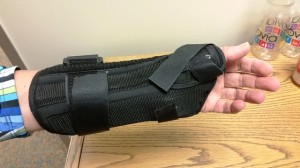
While hiking in Colorado earlier this summer, I suffered an injury with an interesting name – a FOOSH: Fall Onto an Outstretched Hand.
It wasn’t a dramatic injury. I was crossing a river, slipped and wanted
And I got wet anyway. To avoid getting wet. I put out my left arm to try to stop from falling and wound up hurting my hand and wrist.
It sounds silly, but it felt painful. A FOOSH often results in a fracture, but in my case there was just some very serious bruising. My recovery has been swift over the course of about six weeks. I was diligent about following my physical therapy – doing range of motion exercises, and undergoing therapy with electrical stimulation and ultrasound to promote healing. Although I could move my wrist, I wore a brace to help protect the injured area.
I slipped in water, but any kind of slip can result in a FOOSH. Wintertime sports enthusiasts can be especially susceptible due to slips from skating, skiing or snowboarding. But it can happen anytime in many sports – skateboarders and parkour enthusiasts – those who take part in the running, jumping and climbing sport that has become popular in parks and outdoor obstacle courses — regularly suffer from FOOSH injuries.
It’s one of the most common injuries seen in the emergency room, and it can impact the write, forearm, elbow and/or shoulder. Torn rotator cuffs, dislocated shoulders or dislocated elbows are possible.
One of the areas that can be missed in diagnosing a FOOSH injury is a fractured wrist bone, or scaphoid bone. The scaphoid already has a tenuous blood supply, and a fracture can curtail or cut off that blood supply.
Without a good blood supply, the bone tissue dies and the bone collapses. This is called avuncular necrosis. This will lead to arthritis and difficulty or pain in lifting or gripping.
How does a doctor miss a broken bone? Even an X-ray may not clearly show the fracture. This is due, in part, to the complex nature of the wrist joint. It’s made up of eight small bones called the carpal bones. The scaphoid bone is a small carpal bone on the thumb side of the wrist.
Another problem is that patients often self-diagnose the problem as simply a sprained wrist and wait for it to heal on its own. But when the swelling and pain don’t subside after a few days, that’s a pretty sure sign of a fracture.
If you are diagnosed with a fracture, there are two possible courses of treatment – non-surgical and surgical. You might be in a cast for 3-4 months, and your physician likely will want to see you every week for X-rays to check on your healing progress.
You also may be prescribed use of an electrical stimulator to send a small electrical current to your scaphoid bone to help it heal. It’s a little cumbersome and looks like a large bracelet that you’ll have to wear for 10 to 12 hours a day.
If you are still not healing well, surgery may be required using a pin or bone graft to repair the damaged area. You’ll be in a splint for about three months and then physical therapy will be prescribed to help you regain strength and full motion.
Of course, the best way to avoid these injuries is to work on balance and learning to fall properly. We’ve talked in previous blogs about proprioception (balance training), particularly to help young female athletes to avoid injury and improve their skills. We’ll explore in an upcoming blog soon some tips for falling to minimize injury.
Until then, let’s try to avoid a FOOSH.
Dr. Annette “Dr. Z” Zaharoff heads the Non-Surgical Center of Texas, focusing on non-surgical alternatives to relieve pain and repair injuries. A former professional tennis player who competed in the WTC circuit, Dr. Zaharoff remains actively involved with the US Tennis Association. Learn more about her at www.drzmd.com. You can follow her on Facebook at www.Facebook.com/DrZaharoff
